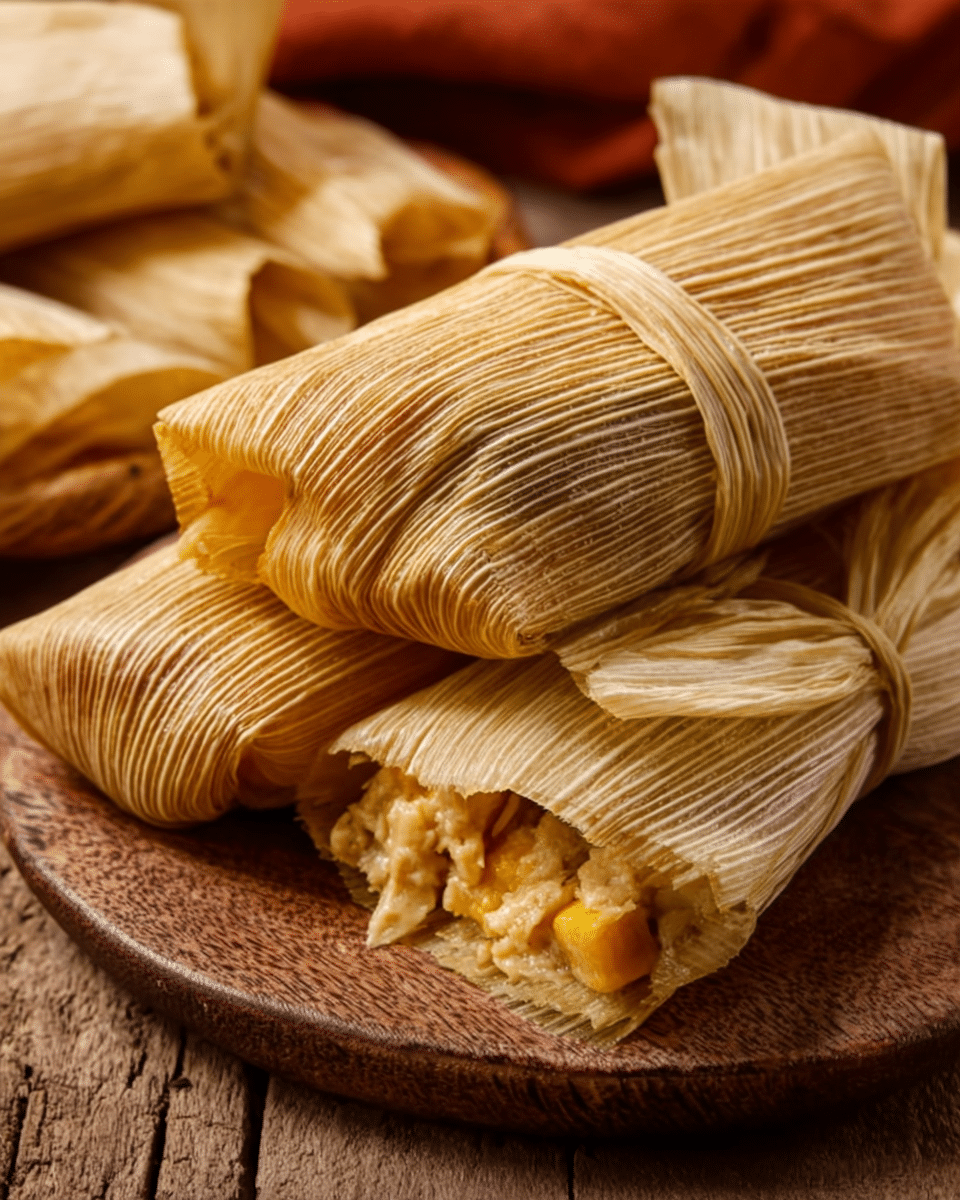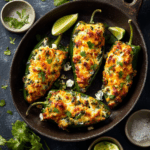Tamales are a cornerstone of Mexican culinary tradition, often made for celebrations and holidays like Independence Day. Tamales de Elote, or sweet corn tamales, offer a delicate, slightly sweet version using fresh corn masa, while pork tamales showcase savory, richly seasoned pork filling wrapped in corn husks.
FULL RECIPE
Ingredients
1.For Tamales de Elote (Sweet Corn Tamales):
- 4 cups fresh corn kernels (or frozen, thawed)
- 1 cup masa harina (corn flour for tamales)
- 1/2 cup granulated sugar
- 1/2 cup unsalted butter, melted
- 1/2 cup whole milk
- 1 tsp baking powder
- 1/2 tsp salt
- Corn husks, soaked in warm water
2.For Pork Filling Tamales:
- 2 lbs pork shoulder, cut into chunks
- 3 dried guajillo chiles, stemmed and seeded
- 2 dried ancho chiles, stemmed and seeded
- 1 medium onion, quartered
- 4 cloves garlic
- 1 tsp ground cumin
- 1 tsp dried oregano
- Salt and pepper to taste
- 2 cups pork broth (reserved from cooking pork)
- Corn husks, soaked in warm water
3.For the Dough (for pork tamales):
- 4 cups masa harina
- 2 tsp baking powder
- 1 tsp salt
- 1 1/2 cups pork lard or vegetable shortening
- 3 cups pork broth (reserved)
Directions
- Prepare the Pork Filling:
- In a large pot, cover pork with water, add onion and garlic, and simmer until tender (about 2 hours). Reserve 2 cups of broth and shred pork once cooled.
- Toast guajillo and ancho chiles in a dry skillet until fragrant. Soak in hot water for 20 minutes, then blend with garlic, onion, cumin, oregano, salt, and pepper to make a smooth sauce.
- Simmer shredded pork in chile sauce for 20 minutes to combine flavors.
- Prepare Tamales de Elote Dough:
Blend corn kernels, sugar, baking powder, and salt until smooth.
Stir in masa harina, melted butter, and milk until well combined and thick but spreadable. - Prepare Pork Tamale Dough:
In a large bowl, beat lard or shortening until fluffy.
Mix masa harina, baking powder, and salt in a separate bowl. Gradually add masa harina mixture and pork broth to the lard, beating until light and airy. - Assemble the Tamales:
Spread a thin layer of dough on the smooth side of soaked corn husks. For sweet tamales, use tamales de elote dough only. For pork tamales, add a spoonful of pork filling in the center before folding.
Fold the sides of the husks in toward the center and fold up the bottom end to seal. - Steam the Tamales:
Arrange tamales upright in a steamer basket over boiling water. Cover with a damp cloth and steam for about 1.5 to 2 hours, adding water as needed. Check doneness by unwrapping one tamal; dough should be firm and separate easily from the husk.
Nutrition Facts
- Calories: 460
- Protein: 25g
- Carbohydrates: 45g
- Dietary Fiber: 5g
- Sugars: 6g
- Fat: 18g
- Saturated Fat: 7g
- Cholesterol: 70mg
- Sodium: 450mg
- Potassium: 520mg
History and Cultural Significance of Tamales
Tamales have been a vital part of Mexican cuisine for thousands of years, dating back to pre-Hispanic times when indigenous peoples prepared these portable meals for warriors and travelers. Traditionally, tamales symbolize community and celebration, often made in large batches during holidays like Mexican Independence Day, Christmas, and Day of the Dead. Tamales de Elote (sweet corn tamales) and pork tamales each hold regional significance, representing the diversity and richness of Mexican culinary traditions.
The Role of Corn in Tamales
Corn, or maize, is a sacred staple in Mexican culture and cuisine. The use of fresh corn kernels in Tamales de Elote adds a natural sweetness and tender texture that distinguishes them from other tamales made with masa harina alone. Corn not only provides carbohydrates but also supplies essential nutrients and fiber. This foundational ingredient connects tamales to ancient agricultural practices and indigenous heritage.
Flavor and Texture Contrast Between Sweet and Savory Tamales
Tamales de Elote offer a subtle sweetness and moist, cake-like texture that contrasts beautifully with the savory, hearty pork tamales, which feature rich, spiced meat wrapped in tender masa. This balance of flavors and textures makes tamales versatile for any meal or occasion. The steaming process ensures the dough remains soft and tender while the fillings infuse with deep, developed flavors.
Nutritional Profile and Health Benefits
Tamales provide a balanced combination of macronutrients, with carbohydrates from the corn dough and protein from the pork filling. Corn also delivers fiber and essential minerals like magnesium and phosphorus. When prepared traditionally with lard, tamales are higher in fat, but modern variations using vegetable shortening or oil can reduce saturated fat content. Additionally, tamales made with fresh corn offer more natural sugars and vitamins than those made solely with masa harina.
Regional and Ingredient Variations
Throughout Mexico, tamales vary widely in ingredients and preparation styles. In some regions, tamales might include chicken, cheese, or vegetables instead of pork, while others feature unique seasonings or wrapping methods using banana leaves instead of corn husks. Tamales de Elote are especially popular in central Mexico and can be enjoyed plain or enhanced with ingredients like cream, cheese, or chili. These variations highlight the adaptability of tamales across Mexican cuisine.
Serving Suggestions and Presentation
Tamales are traditionally served hot, often accompanied by fresh salsa, crema (Mexican sour cream), or a side of beans and rice. For a celebratory meal, tamales de Elote pair wonderfully with sweet drinks like atole or champurrado, while savory pork tamales complement spicy salsas and pickled jalapeños. Presentation can be as simple as unwrapping the corn husk or plating with garnishes like fresh cilantro and lime wedges.
Pairing Tamales with Traditional Mexican Beverages
Beverages play a significant role in tamale enjoyment. Sweet corn tamales are commonly enjoyed alongside warm atole—a corn-based drink flavored with cinnamon or chocolate. For pork tamales, a chilled horchata or a light Mexican beer balances the richness of the meat. These pairings enhance the overall dining experience, creating harmony between flavors and textures.
Storage and Reheating Best Practices
Tamales store very well and can be refrigerated or frozen for later use. To maintain moisture and texture, it’s best to wrap tamales tightly in plastic wrap or aluminum foil. When reheating, steam them gently to avoid drying out the dough and filling. Microwaving is possible but can result in uneven heating and a tougher texture. Proper storage and reheating ensure tamales remain delicious days or weeks after preparation.
Tips for Making Perfect Tamales at Home
Achieving the perfect tamale requires attention to dough consistency, proper soaking of corn husks, and correct steaming technique. The masa dough should be light and fluffy, easily spreadable but not runny. Soaking corn husks until pliable prevents tearing during wrapping. During steaming, maintaining a steady simmer and covering the pot with a cloth helps trap steam evenly, cooking the tamales thoroughly without drying. Practice and patience are key to mastering this traditional dish.
Advertisement
Common Challenges and How to Overcome Them
Making tamales can be labor-intensive, and common mistakes include overly dry dough, leaking tamales, or undercooked masa. To prevent dryness, incorporate enough fat and broth into the masa. For sealing tamales securely, folding husks tightly and ensuring the dough covers the filling well are essential. Using a reliable steamer and allowing adequate cooking time helps ensure the masa cooks through. Troubleshooting these issues can elevate homemade tamales from good to exceptional.
Conclusion
Tamales de Elote and pork tamales represent the heart of Mexican culinary heritage, blending history, culture, and flavor into a dish cherished across generations. Their versatility, from sweet to savory, makes them a beloved food for festive occasions and everyday meals alike. With their rich nutritional profile, variety of regional interpretations, and deep cultural roots, tamales continue to unite families and communities, offering comfort and celebration with every tender, flavorful bite.






